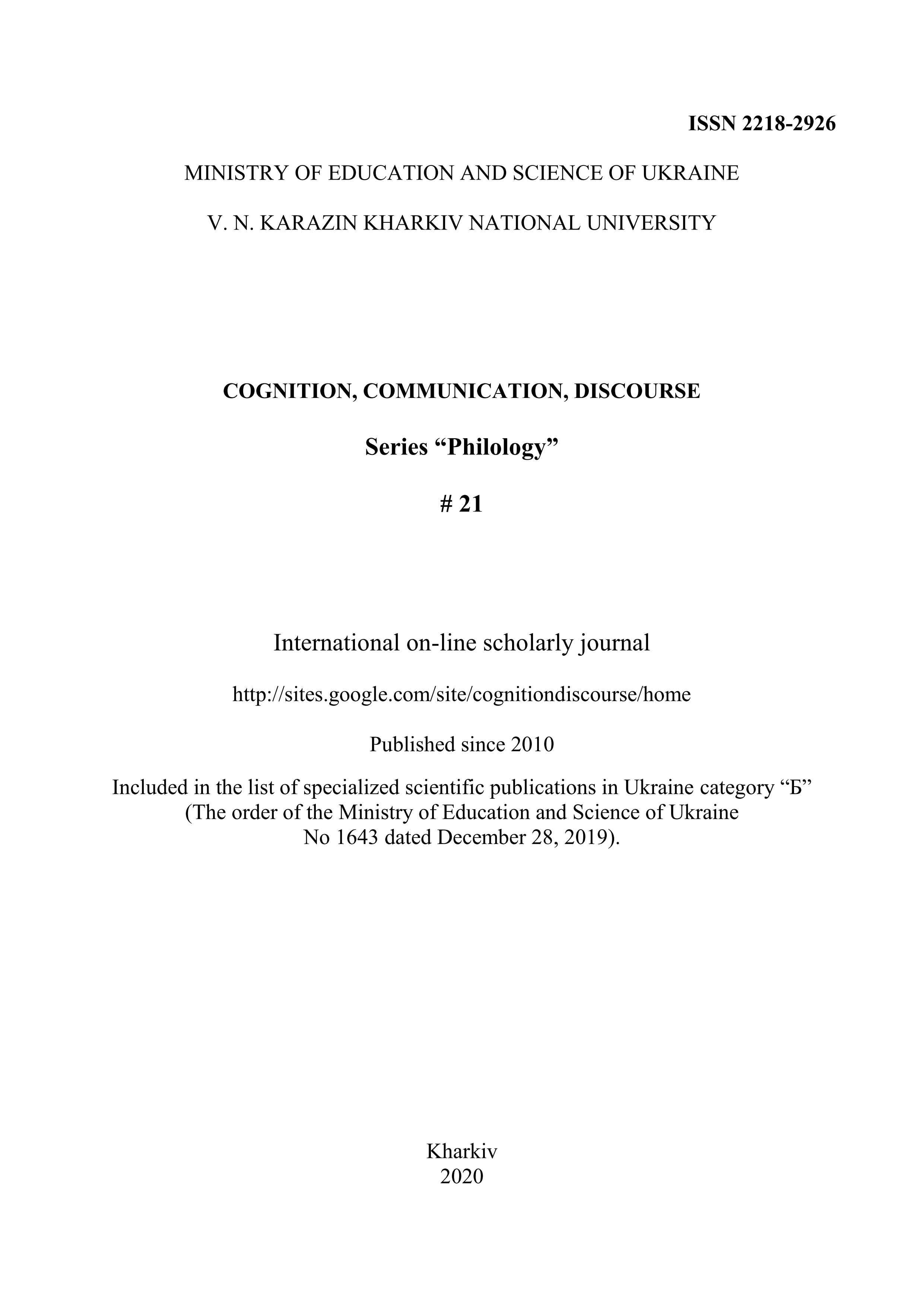Prosodic organization of English utterances of sympathy
Abstract
The paper is a complex study of prosodic organization of English utterances of sympathy. The research is based on functional and communicative approaches to the study of oral communication and is conducted within the framework of psycho-energetic, social and cultural aspects. In order to objectify the data obtained and explain the dynamic interplay of the speakers’ pragmatic aims and their cultures of micro- and macro-societies we also used the apparatus of linguistic synergetics. All the experimental utterances were classified according to their pragmatic orientation, type of communicative situation, speakers’ social statuses, their social and cultural levels and the level of the utterance emotional and pragmatic potentials. On the auditory analysis stage we found out a set of prosodic means typical of English utterances of sympathy having a definite pragmatic orientation (sympathy proper, compassion, consolation, encouragement). Besides, we singled out the invariant intonation pattern and specific features of its variant realizations. The analysis of video data allowed us to describe the interplay of prosodic means with paralinguistic, lexical and grammatical means as well as define the role of phonetic means in proper decoding of sincerity or insincerity of English utterances of sympathy. Acoustic analysis enabled us to instrumentally verify the data obtained during the auditory stage of the experiment and identify the variant and invariant patterns of English utterances of sympathy prosodic organization. Linguistic interpretation of the obtained results made it possible to model the synergetic processes of the utterances of sympathy self-development based on the individuals’ personal communicative experience acquired within his/her micro- and macro-societies cultures. Using such modeling, we managed to identify that generation and actualization of sympathy of a certain pragmatic type is only possible due to the presence of phonoconcepts prototypes in the individual’s memory, which, in their turn, are able to form one of the four invariant intonation patterns.
Downloads
References
Debes, R. (2017). Empathy and mirror neurons. In Maibom, H. (Ed.), The Routledge handbook of philosophy of empathy (pp. 54–63). London : Routledge.
Dolia, I. (2013).Vplyv hendernoho faktoru na intonatsiinu variatyvnist pozytyvnykh ta nehatyvnykh otsinnykh vyslovlen v anhlomovnomu sotsialno-informatyvnomu radio dyskursi. [Influence of the gender factor on intonation variation of positive and negative evaluative statements in the English social-informative radio discourse]. Naukovi zapysky Vinnytskoho derzhavnoho pedahohichnoho universytetu imeni Mykhaila Kotsubynskoho. Seriia “Filolohia. Movoznavstvo”, 17, 194–199.
Johnston, D. (2002). CoolEditPro. (Version 1.2) [Computer Software]. Syntrillium Software Corporation. P.O. Box 62255, Phoenix, FZ 85082-2255, USA.
Hoffman, M. L. (2001). Empathy and moral development: implications for caring and justice. Cambridge: Cambridge University Press.
Kazachkova, Yu. V. (2006). Vyrazhenie sochuvstvia v russkom I angliiskom rechevom obshchenii (zanrovyi askpekt) [Expression of sympathy in Russian and English speech (genre aspect)] (Unpublished candidate dissertation). Saratov University, Saratov, Russia.
Kalyta, A. A. (2001). Fonetychni zasoby aktualizatsii smyslu anhliiskoho emotsiinoho vyslovluvanna. [Phonetic means actualizing the meaning in English emotional utterances]. Kyiv: KDLU.
Kalyta, A. A., & Taranenko, L. I. (2009). Kohnityvnyi pidhid do vyvchennia fonetychnykh zasobiv movy. [Cognitive approach to the study of phonetic means]. Naukovyi visnyk Chernivetskoho universytetu, 441–443, 3–6.
Kalyta, A. A., & Taranenko, L. I. (2012). Kriterii urovnya aktualizatsii emotsionalno-pragmaticheskogo potentsiala vyskazyvaniya. [Criterion defining the level of the utterance emotional-and-pragmatic potential]. Naukovi zapysky Kirovohradskoho derzhavnoho pedahohichnoho universytetu imeni Volodymyra Vynnychenka. Seriia: Filolohichni nauky (movoznavstvo), 105(1), 476–484.
Klymeniuk, O. V. (2010). Znanie, poznanie, kognitsiya [Knowledge, learning, cognition]. Ternopil: Pidruchnyky i posibnyky.
Mehrabian, A., & Epstein, N. (1972). A measure of emotional empathy. Journal of Personality, 40(4), 525–544.
Pierrehumbert, J. (1993). Prosody, intonation, and speech technology. In M. Bates, & R. Weischedel (Eds.), Challenges in natural language processing (pp. 257–282). Cambridge: Cambridge University Press.
Scheler, M. (2017). The nature of sympathy. London: Routledge.
Sound Technology, Inc. (1997). SpectraLab (Version 4.3213) [Computer Software]. 1400 Dell Avenue. Campbell, CA 95008 USA.
Sugiharto, S. (2008). А sociopragmatic analysis on sympathy and empathy utterances in movie manuscript (Bachelor’s thesis, Universitas Muhammadiyah of Surakarta, Surakarta, Indonesia). Retrieved from: http://eprints.ums.ac.id/679
Tatham, M. A. (1987). Cognitive phonetics—some of the theory. In R. Channon, & L. Shockey (Eds.), In honor Ilse Lehiste (pp. 271–276). Dordrecht: Foris Publications.
Tatsenko, N.V. (2017). Realizatsiia empatii v suchasnomu anhlomovnomu dyskursi: kohnityvno-synerhetychnyi aspekt [Realization of empathy in modern English discourse]. Sumy: SDU.
Zhuravliova, L. P. (2008). Rodyna yak vahomyi kulturohennyi factor aktualizatsii ta rozvytku empatii osobystosti [Family as an important cultural factor of actualization and development of empathy]. Aktualni problemy psykholohii, 10(8), 225–231.
Copyright (c) 2020 Larysa Taranenko, Mykola Kutsenko

This work is licensed under a Creative Commons Attribution-NonCommercial-NoDerivatives 4.0 International License.
Authors, who publish with this journal, accept the following conditions:
The authors reserve the copyright of their work and transfer to the journal the right of the first publication of this work under the terms of the Creative Commons Attribution License (CC BY), which allows other persons to freely distribute a published work with mandatory reference to the authors of the original work and the first publication of the work in this journal.
Authors have the right to enter into separate additional agreements for the non-exclusive dissemination of the work in the form in which it was published by this journal (for example, to post the work in the electronic institutions' repository or to publish as part of a monograph), provided that the link to the first publication of the work in this journal is given.
The journal policy allows and encourages the authors to place the manuscripts on the Internet (for example, in the institutions' repositories or on personal websites), both before the presentation of this manuscript to the editorial board and during review procedure, as it contributes to the creation of productive scientific discussion and positively affects the efficiency and dynamics of citing the published work (see The Effect of Open Access).




